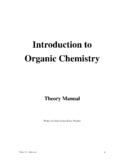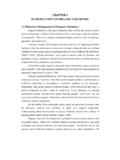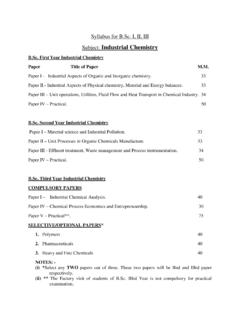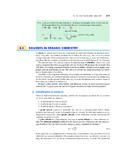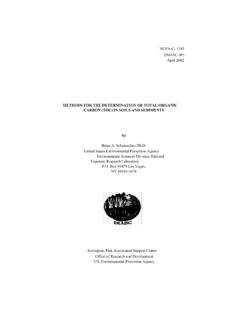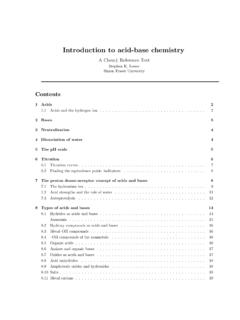Transcription of Introduction to Biodiesel Chemistry
1 Prepared by John Bush for Biodiesel Collective Conference 2008 contact: Introduction to Biodiesel Chemistry Terms and Background Information Basic Organic Chemistry Organic Chemistry is the branch of Chemistry that deals with organic compounds. Organic compounds are compounds that (with a few exceptions such as carbon dioxide gas) contain the element carbon. The properties of organic compounds are dependent primarily on the physical structure of the molecules and by the presence of functional groups, which categorize organic compounds in different groupings, such as alcohols, acids, esters, aldehydes, or ketones, just to name a few. If a component of an organic compound is not important to the reaction being defined, it is often represented on paper as R, which indicates organic rest. What is Biodiesel ? Biodiesel is composed of mono alkyl esters of long chain fatty acids derived from renewable lipid sources, such as vegetable oil or animal fats.
2 Esters are organic compounds composed of an alcohol and an organic acid. Alcohols are organic compounds that contain a functional group OH (hydroxide). Carboxylic acids are organic compounds that contain a functional group COOH (carboxyl). Long chain fatty acids are carboxylic acids that are composed of single chains of 12 to 24 carbons with a carboxyl group. What is Vegetable Oil? Vegetable oil is composed of triglycerides of long chain fatty acids attached to glycerol, which is a type of alcohol. Each triglyceride contains one glycerol and three long chain fatty acids. The process used to make Biodiesel is called transesterification because it is a process of transforming one type of ester into another. prepared by John Bush for Biodiesel Collective Conference 2008 contact: Examples of Organic Compounds Alcohols containing a hydroxyl group OH Methanol Ethanol CH3OH CH3CH2OH Carboxylic Acids containing a carboxyl group COOH Formic (Methanoic) Acid Acetic (Ethanoic) Acid CH2O2 CH3 COOH Esters alcohols bonded to acids Ethyl Acetate C4H8O2 prepared by John Bush for Biodiesel Collective Conference 2008 contact: Glycerol, Fatty Acids, Triglycerides, and Biodiesel Glycerol (Glycerine) Fatty Acids Triglyceride Fatty Acid Ester of Glycerol Biodiesel Fatty Acid Ester of a Simple Alcohol prepared by John Bush for Biodiesel Collective Conference 2008 contact: Biodiesel Chemistry Reactions Contributing to Methyl Ester Production 1.
3 Transesterification of Fats (Triglycerides) to form Fatty Acid Methyl Esters and Glycerol 1 Triglyceride + 3 Methanol 3 Methyl Ester + 1 Glycerol The fatty acid R groups remain unchanged This reaction is facilitated with a strong base catalyst 2. Reaction of Catalyst (NaOH) with Methanol CH3OH + NaOH CH3O-Na + H2O CH3O-Na exists as the anion CH3O- and the cation Na+ 3. The reaction of Methoxide with Triglyceride O O || || CH2-O-C-R CH2-O-C-R | | | O | O | || | || CH-O-C-R + CH3O- CH-O- + CH3O-C-R | | | O | O | || | || CH2-O-C-R CH2-O-C-R Triglyceride + Methoxide Triglyceride Anion + Methyl Ester The triglyceride anion then needs a proton to form a diglyceride. If the proton comes from another methanol, a new methoxide ion is formed, regenerating the catalyst.
4 Prepared by John Bush for Biodiesel Collective Conference 2008 contact: Biodiesel Chemistry Reactions Inhibiting Methyl Ester Production 1. Hydrolysis of Triglyceride to form Diglyceride and Free Fatty Acid O O || || CH2-O-C-R CH2-O-C-R | | | O | O | || | || CH-O-C-R + H2O CH-OH + HO-C-R | | | O | O | || | || CH2-O-C-R CH2-O-C-R This reaction is particularly prevalent in deep fryers, and is the primary reason used cooking oil contains free fatty acids It can also happen during Biodiesel processing. The presence of a base catalyst facilitates this reaction in a similar way as it facilitates transesterification, except the end result is soap. 2. Reaction of Alkali Catalyst with Free Fatty Acid to form Soap NaOH + HOC(O)R H2O + Na-OC(O)R Note that water is also a product Summary: Water can react in a similar way as methanol with triglycerides, except it results in free fatty acid production.
5 Free fatty acids form soaps with alkali catalysts. Therefore, either the presence of water or free fatty acids will limit the effectiveness of the catalyst and inhibit the completion of the transesterification reaction that produces methyl ester.
